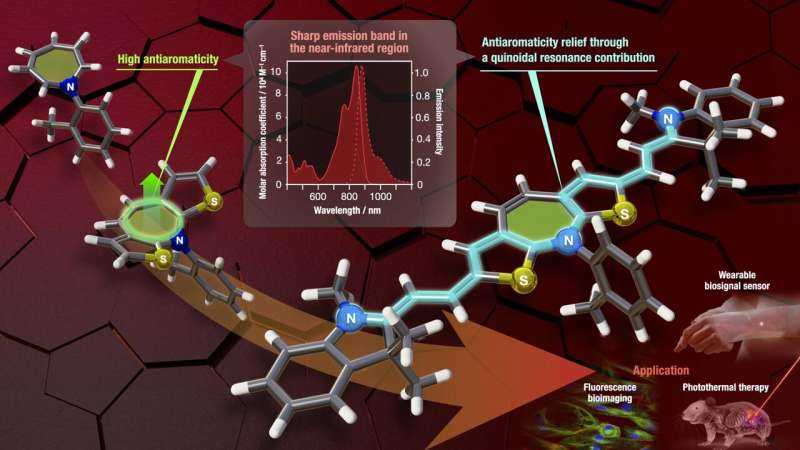This article has been reviewed according to Science X's editorial process and policies. Editors have highlighted the following attributes while ensuring the content's credibility:
fact-checked
peer-reviewed publication
trusted source
proofread
Research team develops antiaromatic molecules that exhibit absorption and fluorescence bands in near-infrared region

A research group led by Associate Professor Masahito Murai of the Graduate School of Science and Professor Shigehiro Yamaguchi of the Functional Organic Materials Laboratory has successfully developed antiaromatic molecules that exhibit absorption and fluorescence bands in the near-infrared (NIR) region, a region that is important for medical devices.
Their findings, published in Angewandte Chemie International Edition, suggest applications for the advancement of the fields of health care, optoelectronics, and materials science.
Absorption and fluorescence are fundamental research subjects in spectroscopy, a field that explores the interaction between light and matter. These photophysical properties are crucial for understanding how molecules and materials behave when exposed to light.
An absorption band represents the specific range of wavelengths where a material absorbs light, causing electrons within the molecules or atoms to transition to higher energy states. Fluorescence bands, on the other hand, relate to the emission of light by a substance that has previously absorbed light, with the emitted light having a longer wavelength than the absorbed light.
The significance of this research lies in the development of organic molecules that emit light in the NIR region, specifically wavelengths between 800 and 1100 nm. This region, known as the "optical window of living tissue," offers unique advantages in medical applications, including deep biological imaging, photodynamic therapy, and photothermal therapy. NIR light can penetrate tissues more deeply with reduced scattering and minimal photodamage, making it an invaluable tool in health care and life science research.
"Organic molecules exhibiting absorption and emission properties in the near-infrared region are in strong demand for optoelectronic materials in health care applications and fluorescence imaging, such as fluorescent probes for deep biological imaging, photodynamic therapy, and photothermal therapy," Murai explained.
"However, conventional dyes often suffer from reduced solubility and increased lipophilicity due to the strong interactions between largely extended π-electron systems. These problems make it difficult to mold and process the molecules for use as electronic materials and to apply them to biological imaging."
The key to the team's success lays in the fusion of thiophene, a less aromatic heterocyclic ring, with azepine. This fused ring structure effectively balanced antiaromatic and polymethine characters to make electronic transitions of antiaromatic compounds more likely to occur, and as a result, enabling the acquisition of absorption and fluorescence wavelengths in the NIR region. This breakthrough holds the potential to lead to the creation of diverse NIR luminescent materials.
The team designed and synthesized a series of azepine derivatives with electron-accepting groups and used single-crystal X-ray structure analysis to reveal significant structural differences between them.
While the curved dibenzoazepine exhibited absorption and fluorescence at shorter wavelengths, the highly planar dithienoazepine analog exhibited absorption and fluorescence at wavelengths longer than 700 nm. The molecular framework's utility was further demonstrated by synthesizing a dithienoazepine with cationic indolium groups, which displayed a strong absorption band at 846 nm and a narrow fluorescence band at 878 nm.
Overall, their research introduces a promising avenue for the development of materials with strong absorption and fluorescence properties in the NIR range. Dithienoazepine was a useful core that could achieve long-wavelength absorption and emission despite its small tricyclic skeleton.
The application potential spans a wide array of fields, including fluorescence imaging, sensing, and materials science, with a particular focus on deep-tissue imaging and non-invasive diagnostics, highlighting Nagoya University's commitment to pushing the boundaries of science and innovation to improve health care using cutting-edge technology.
More information: Masahito Murai et al, Dithienoazepine‐Based Near‐Infrared Dyes: Janus‐Faced Effects of a Thiophene‐Fused Structure on Antiaromatic Azepines, Angewandte Chemie International Edition (2023). DOI: 10.1002/anie.202311445
Journal information: Angewandte Chemie International Edition





















